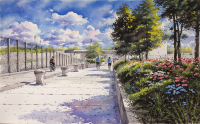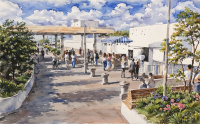
The Bellevue Grand Connection: I-405 Crossing, also referred to as the Grand Connection Crossing, is part of the city’s broader initiative led by the Office of the Grand Connection to transform our public spaces along the corridor between Meydenbauer Bay and Eastrail.
The Grand Connection Crossing is the heart of the Grand Connection program and the key to making downtown more accessible for all who live, work, learn or play in Bellevue.
The Crossing will:
- Provide a safe and vehicle-free crossing over I-405 for people who walk, bike and roll.
- Improve connectivity from downtown to the wider region by linking to the Eastrail and 175 miles of trails.
- Offer opportunities for more public spaces in Downtown and Wilburton through coordination with both public and private redevelopment.
Project status
This summer, the Grand Connection Crossing design team refined the visionary 30% design concepts to reflect a more feasible project cost and delivery schedule while still maintaining community amenities and features.
- Crossing width: The crossing will be a minimum of 30 feet wide and widen up to 40 feet to cross over I-405.
- Mode separation: There will be separate paths for people walking and rolling to improve safety for all users.
- Landscaping: Landscaping will be incorporated along the entire crossing.
- Gathering space: There will be gathering space at either end of the crossing. In addition, the city will coordinate with adjacent private development to provide additional public space.
- Vertical connections: There will be two public access points at 112th and 116th Avenues NE with an elevator and stairway.
- City Hall Plaza: The existing plaza will be modified to accommodate public gathering and improved Downtown access for those biking, walking and rolling to and from the crossing.
- Development partnerships: The city will partner will developers to deliver the segment east of I-405 from 116th Avenue NE to the tie-in with Eastrail. The design will also allow for future developments along the alignment to connect with the crossing.
Bellevue received approval from the State’s Capital Projects Advisory Review Board’s Project Review Committee (PRC) to deliver the crossing using the General Contractor / Construction Manager (GC/CM) methodology in late September 2025. Advantages to using a GC/CM include reduction of construction risks and greater cost certainty. The city is preparing to issue an RFP for procuring a GC/CM contractor in early 2026. Design work will resume once the contractor is selected and joins the Design Team.
Funding
The city estimates the Crossing will cost $175–230 million, covering design, property acquisition, and construction, and is developing a multi-tiered funding strategy.
The city is currently evaluating the creation of a Tax Increment Financing (TIF) district. Establishing a TIF district would allow Bellevue to capture future increases in property value from sites expected to redevelop as a result of the Crossing. Bellevue will submit an analysis to the State for review and approval in January 2026 and will share preliminary financial projections with regional taxing districts throughout fall 2025.
Bellevue is also exploring additional funding strategies, including potential activation of the Transportation Benefit District approved by the City Council in 2023, as well as available grant and philanthropic opportunities. To date, funding includes $2.5 million from the Friends of the Grand Connection for preliminary design work and $46.7 million committed from the city’s 2025–2030 Capital Investment Program to advance design.
-
Timeline
- 2026
- Advance design work and funding strategy
- Advance crossing to 60% design
- Submit analysis for proposed TIF District to the Office of the State Treasury and regional taxing jurisdictions who will decide to opt-in or out of the TIF.
- Select GC/CM contractor who will provide input on cost, constructability, scheduling, and risk management alongside the design team and city staff.
- 2025
- Refinement of 30% design and funding strategy
- Requested permission from PRC for Bellevue to deliver the project using a GC/CM methodology
- Selected HNTB to serve as an Owner Advisor for GC/CM development
- Finalized the refined 30% design concept
- Establish the Office of the Grand Connection to deliver the Crossing and other projects associated with the Grand Connection
- 2024
- 30% design activities
- Developed the 30% preliminary design concept
- Conducted community engagement through surveys and/or in-person discussions with community members
- Completed environmental and engineering analysis
- 2023
- Project kick-off
- Selected WSP to develop the 30% preliminary design for the crossing
- 2021-2022
- Initial feasibility and concept studies
- Amazon funded early work to develop a concept for a future I-405 Crossing and donated the outcomes of this work to the city.
Get involved
More information on this developing project and on how to get involved will be shared in advance of major milestones. For more information and to sign up for email or text alerts, select “Subscribe” under Alerts.
Local businesses and non-profits interested in learning more about the regional stakeholder group championing this work can learn more at the Friends of the Grand Connection.
Project Documents
- Refined 30% Urban Design Report (September 2025)
- Industry Outreach Presentation (October 2025)
- Structural Type, Size and Location Report
- Appendix A: Preliminary Drawings & Exhibits
- Appendix B: Quantity & Cost Estimate Calculations
- Appendix C: Bridge Structure Basis of Design (BOD)
- Appendix D: As-Built Plans
- Appendix E: Public Engagement Plans & Reports
- Appendix F: Alternative Alignment Report
- Appendix G: Transportation Technical Report
- Appendix H: Additional Technical Reports
- Alignment Alternatives Report
- Feasibility Study
Outreach Materials
- 30% Design Engagement Summary (December 2024)
- In-person Open House Summary (May 2024)
- Online Open House Summary (March 2024)
- Design Charette Summary (December 2023)
- Concept Plan
Please note that assumptions, renderings and designs included in these documents are purely conceptual renderings and meant for discussion purposes only. Further engineering, site planning, environmental analysis and other work will be necessary to determine the viability of these concepts and design a preferred alternative.
Frequently Asked Questions
When will the Grand Connection Crossing be complete?
The initial delivery of the crossing that includes connectivity from City Hall Plaza to Eastrail is anticipated to open in 2030. Projects to incorporate additional amenities or advance the future park lid will be evaluated in the coming years.
How will the city deliver this project?
The State’s Capital Projects Advisory Review Board’s (CPARB) Project Review Committee (PRC) approved Bellevue’s application to use the GC/CM delivery method in late September 2025.
HNTB was selected as an Owner Advisor who will guide the city through the complex approval and procurement processes associated with the GC/CM delivery method.
Why is the city using a GC/Cm delivery method?
GC/CM is often used for complex infrastructure projects because it supports collaboration, better cost control, and a more efficient construction process. This approach brings a contractor onto the team early in design, allowing construction experts to work directly with city staff and designers to identify cost-saving opportunities, improve constructability, and manage risks.



